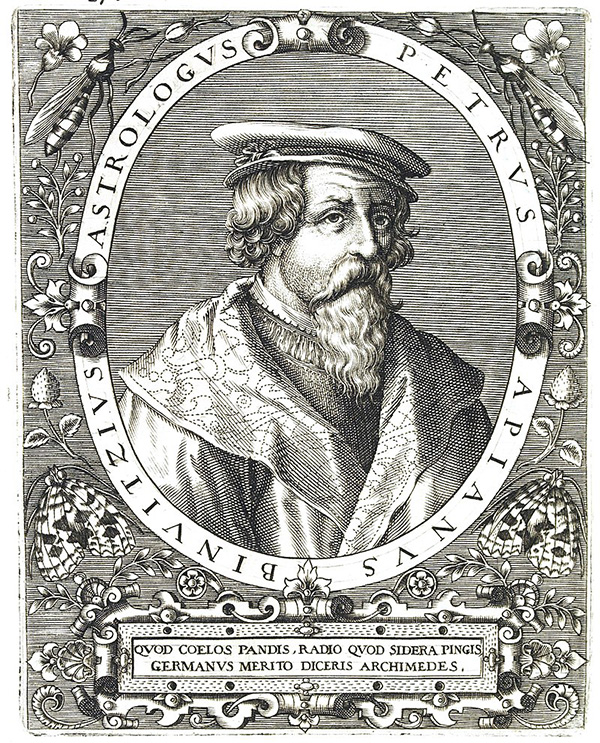Petrus Apianus, or Peter Apian (April 16, 1495 – April 21, 1552) was a German humanist, astronomer, mathematician and professor who lived and worked in Ingolstadt and Vienna. He produced the most popular textbook on astronomy in the 16th century, the Cosmographicus Liber, and is known for his map of the world which until the rediscovery of Martin Waldseemüller's 1507 wall map was thought to be the first to use the place-name 'America.' His works were influential and were published in many languages, into the 17th century.
He was born as Peter Bienewitz in Saxony; his father, though not poor, was a Leisnig shoemaker. He gained an education and would between 1516 and 1519 study at the University of Leipzig. As is typical for academics of this era, he Latinized his name. The root of his German name, 'Biene,' is the word for 'bee;' hence, the Latin version of his name would be 'Apianus' (from the Latin 'Apis.' The humanists enjoyed word play.
From Leipzig, Apianus moved to Vienna to continue his studies. It was there that he would have encountered the monumental Waldseemüller map, which would inform his own 1520 map. Upon receiving his BA Apianus abandoned the plague-stricken Vienna for Landshut where he would produce his Cosmographicus liber in 1524. This, his magnum opus of astronomy and navigation, would be in print long after his death. Starting in 1527 he would operate a print shop in Ingolstatd, producing works contributing to the religious debates of his time, and printing many fine geographic and cartographic works. He came to the attention of emperor Charles V, whose admiration brought the scholar and printer a privilege in 1532 and 34; he would go on to become the emperor's court cosmographer and mathematician, a knight, and in time an Imperial Count Palatine. He married the daughter of a Landshut Councilman, and together they would have fourteen children.
He was born as Peter Bienewitz in Saxony; his father, though not poor, was a Leisnig shoemaker. He gained an education and would between 1516 and 1519 study at the University of Leipzig. As is typical for academics of this era, he Latinized his name. The root of his German name, 'Biene,' is the word for 'bee;' hence, the Latin version of his name would be 'Apianus' (from the Latin 'Apis.' The humanists enjoyed word play.
From Leipzig, Apianus moved to Vienna to continue his studies. It was there that he would have encountered the monumental Waldseemüller map, which would inform his own 1520 map. Upon receiving his BA Apianus abandoned the plague-stricken Vienna for Landshut where he would produce his Cosmographicus liber in 1524. This, his magnum opus of astronomy and navigation, would be in print long after his death. Starting in 1527 he would operate a print shop in Ingolstatd, producing works contributing to the religious debates of his time, and printing many fine geographic and cartographic works. He came to the attention of emperor Charles V, whose admiration brought the scholar and printer a privilege in 1532 and 34; he would go on to become the emperor's court cosmographer and mathematician, a knight, and in time an Imperial Count Palatine. He married the daughter of a Landshut Councilman, and together they would have fourteen children.


